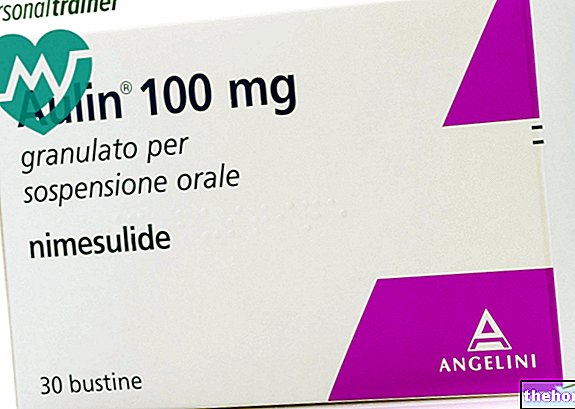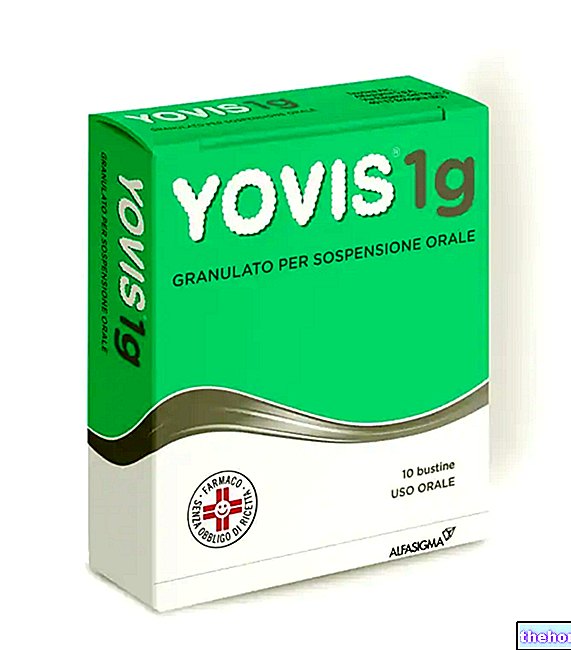Active ingredients: Diflucortolone (diflucortolone valerate), Josamycin (josamycin propionate)
CORTI-FLUORAL 1.2 MG / ML + 5.34 MG / ML SOLUTION FOR ORAL MUCOSA
Why is Corti-fluoral used? What is it for?
Corti-Fluoral is a medicine that contains two active ingredients: diflucortolone, which belongs to the category of corticosteroids (cortisone), and josamycin, which belongs to the category of macrolide antibiotics, for the treatment of the local oral mucosa.
Corti-Fluoral is used for treating the following conditions:
- periodontal disease (alveolar pyorrhea, ie inflammation of the tissues that fix the tooth to the bone);
- periodontitis (inflammation of the tissues surrounding the tooth root);
- gingivitis (inflammation of the gums);
- fused-spirillary stomatitis (inflammation of the mouth due to particular bacteria);
- aphthous stomatitis (inflammation of the mouth with the formation of small ulcers)
- inflammatory and ulcerative lesions of the oral mucosa of any other origin, including those due to certain diseases, such as pemphigus (skin disease, often autoimmune, with the formation of blisters) and polymorphic erythema (skin disease characterized by reddish target).
Contraindications When Corti-fluoral should not be used
Do not use Corti-Fluoral
- if you are allergic to diflucortolone valerate, josamycin propionate or any of the other ingredients of this medicine (listed in section 6);
- if in the area to be treated there are tuberculous, luetic (due to syphilis) or viral lesions (vaccine pustules, herpes zoster, chicken pox).
Precautions for use What you need to know before taking Corti-fluoral
Talk to your doctor or pharmacist before using Corti-Fluoral. The use, especially if prolonged, of products for topical use can give rise to sensitization phenomena.
It cannot be excluded that treatment, especially if prolonged, with josamycin, as with other antibiotics (even belonging to the same group), can cause resistant bacteria and fungi to develop. In this case, stop the treatment and contact your doctor, who will prescribe a suitable therapy for you.
For those who carry out sporting activities
The use of the drug without therapeutic necessity constitutes doping and can in any case determine positive anti-doping tests.
Children
The medicine should be used in pediatric age only in cases of real need and under the direct supervision of the doctor.
Interactions Which drugs or foods can modify the effect of Corti-fluoral
Tell your doctor or pharmacist if you are taking, have recently taken or might take any other medicines. In particular, tell your doctor if you are taking an antihistamine called terfenadine.
Warnings It is important to know that:
Pregnancy and breastfeeding
If you are pregnant or breast-feeding, think you may be pregnant or are planning to have a baby, ask your doctor or pharmacist for advice before using this medicine.
Use this medicine only when clearly needed and under the direct supervision of your doctor.
Driving and using machines
Corti-fluoral does not affect the ability to drive and use machines.
Dose, Method and Time of Administration How to use Corti-fluoral: Posology
Always use this medicine exactly as your doctor or pharmacist has told you. If in doubt, consult your doctor or pharmacist.
The recommended dose is two applications, one in the morning and one in the evening.
In acute or particularly severe cases, apply the medicine several times a day
How to use
Drop a few drops of the solution on a cotton swab and apply it to the wound.
In the case of gingivitis or pyorrhea, massage with the cotton swab, making the medicine penetrate deep into the gum pockets. In these cases you use medicine even during normal dental cleaning, dropping 2-3 drops of solution on the toothbrush, together with the toothpaste or after using it, rubbing moderately. This method of use is also advantageous in forms of canker sores with prevalent localization to the gums. Naturally, in these cases, the massage should not be very energetic and carried out with a soft bristle brush.
Do not swallow the medicine. Corti-Fluoral is for oral mucosa only.
Overdose What to do if you have taken too much Corti-fluoral
There are no known cases of drug overdose. However, accidental ingestion of the entire bottle is not capable of causing toxic effects. If you have any further questions on the use of this medicine, ask your doctor or pharmacist.
Side Effects What are the side effects of Corti-fluoral
Like all medicines, this medicine can cause side effects, although not everybody gets them. There are rare episodes of burning and irritation locally. Reporting of side effects If you get any side effects, talk to your doctor or pharmacist. This includes any possible side effects not listed in this leaflet. You can also report side effects directly via the national reporting system at http://www.agenziafarmaco.gov.it/it/responsabili. By reporting side effects you can help provide more information on the safety of this medicine.
Expiry and Retention
Keep this medicine out of the sight and reach of children.
Do not use this medicine after the expiry date which is stated on the bottle label and carton after "Expiry". The expiry date refers to the last day of that month. Do not store above 25 ° C.
Composition and pharmaceutical form
What Corti-Fluoral contains
- The active ingredients are diflucortolone valerate and josamycin propionate. 1 ml of solution contains 1.20 mg of diflucortolone valerate and 5.34 mg of josamycin propionate, equivalent to 5.00 mg of josamycin base.
- The other ingredients are: triglycerides of saturated fatty acids.
Description of what Corti-Fluoral looks like and contents of the pack
Oromucosal solution in 10 ml bottle.
Source Package Leaflet: AIFA (Italian Medicines Agency). Content published in January 2016. The information present may not be up-to-date.
To have access to the most up-to-date version, it is advisable to access the AIFA (Italian Medicines Agency) website. Disclaimer and useful information.
01.0 NAME OF THE MEDICINAL PRODUCT
SHORT-FLUORAL
02.0 QUALITATIVE AND QUANTITATIVE COMPOSITION
100 g contain:
diflucortolone valerate 0.120 g
josamycin propionate 0.534 g equivalent to josamycin base 0.500 g
03.0 PHARMACEUTICAL FORM
Solution for oral mucosa
04.0 CLINICAL INFORMATION
04.1 Therapeutic indications
Periodontal diseases (alveolar pyorrhea), periodontitis, gingivitis, fused-spirillary stomatitis, aphthous stomatitis and inflammatory and ulcerative lesions of the oral cavity mucosa of any other origin, including those of some particular morbid forms such as pemphigus and polymorphic erythema.
04.2 Posology and method of administration
The application of the drug in acute or particularly serious cases should be repeated several times a day. Normally it can be done twice (morning and evening), dropping a few drops of solution on a cotton swab with which the lesion will be touched .
In the case of gingivitis or pyorrhea it is necessary to perform a massage with a soaked cotton swab, trying to penetrate the medicine deeply into the gum pockets: in these cases it is useful to use the drug even during normal dental cleaning, making it fall 2-3 drops of the medicine on the toothbrush together with the toothpaste or after using it, rubbing moderately. This method of use is also advantageous in forms of canker sores with a prevalent localization of the gums: naturally in these cases the massage must not be very energetic and carried out with a soft bristle brush.
The product is for oral mucosa only. Do not swallow.
04.3 Contraindications
Presence in the area to be treated of tuberculous, luetic and viral processes (vaccine pustules, herpes zoster, chicken pox).
Hypersensitivity to one of the components of the product.
04.4 Special warnings and appropriate precautions for use
The use, especially if prolonged, of products for topical use, can give rise to sensitization phenomena.
Although no reports of this have been received yet, it cannot be ruled out that treatment, especially if prolonged, with josamycin, as with other antibiotics, including those of the macrolide group, may give rise to the proliferation of resistant bacterial agents and fungi; in this eventuality the treatment will be interrupted and an appropriate therapy instituted.
04.5 Interactions with other medicinal products and other forms of interaction
Systemically administered josamycin can significantly alter the metabolism of terfenadine resulting in a relative overdose.
04.6 Pregnancy and lactation
In pregnant women, during lactation, and in pediatric age, the product should be administered only in cases of real need and under the direct supervision of the doctor.
04.7 Effects on ability to drive and use machines
Nobody.
04.8 Undesirable effects
Proper use of the drug does not allow to predict systemic effects. There are rare episodes of burning and irritation locally.
04.9 Overdose
There are no known cases of overdose of the product. However, accidental ingestion of the entire bottle is not capable of causing toxic effects.
05.0 PHARMACOLOGICAL PROPERTIES
05.1 Pharmacodynamic properties
Diflucortolone valerate is endowed with intense anti-inflammatory activity which was found to be 3 to 30 times higher than that of other topical corticosteroids used as a comparison.
Josamycin is an antibiotic of the macrolide family whose antibacterial spectrum includes Gram positive and Gram negative bacteria including obligate anaerobes, belonging to species commonly implicated in the etiology of odontostomatological infections.
05.2 Pharmacokinetic properties
Diflucortolone valerate after topical application penetrates rapidly into the human epidermis, where within four hours it reaches its maximum concentration. Its reabsorption into the circulation is less than 1% of a dose applied to the skin for a prolonged time (7 hours). Intracutaneous concentration is prevalent in the superficial layers.
Josamycin, stable at gastric pH, is absorbed immediately and reaches high plasma concentrations. Plasma protein binding is around 15%; the drug diffuses into the tissues, rapidly reaching therapeutic concentrations. In particular, josamycin after oral administration reaches higher and persistent salivary concentrations than plasma ones, josamycin is able to reach concentrations higher than plasma ones in the jaw bone, in healthy and diseased gums.
Excretion occurs mainly through the intestinal tract.
05.3 Preclinical safety data
The toxicity of diflucortolone valerate is negligible; tests performed with topical applications have confirmed the absence of a determinable acute toxicity; similarly the acute toxicity of josamycin is very low, it is not able to exert acute toxic effects up to doses of 7000 mg / kg orally and 3000 mg / kg subcutaneously.
06.0 PHARMACEUTICAL INFORMATION
06.1 Excipients
Triglycerides of saturated fatty acids having a length between C8 and C10
06.2 Incompatibility
There are no known incompatibilities between the combination of lucortolone valerate and josamycin and other drugs.
06.3 Period of validity
2 years.
06.4 Special precautions for storage
Do not store above 25 ° C.
06.5 Nature of the immediate packaging and contents of the package
Class III dark glass vial, closed by a polypropylene screw cap, with low density polyethylene gasket and dispensing reducer.
Bottle of 10 ml.
06.6 Instructions for use and handling
None.
07.0 MARKETING AUTHORIZATION HOLDER
MA holder: Bayer S.p.A. - Viale Certosa, 130 - 20156 Milan
08.0 MARKETING AUTHORIZATION NUMBER
AIC n. 017651035
09.0 DATE OF FIRST AUTHORIZATION OR RENEWAL OF THE AUTHORIZATION
16.06.1987/01.06.2005
10.0 DATE OF REVISION OF THE TEXT
June 2007




























